Research and Application of Factory Hydroponic Technology in Wheatgrass Greenhouse
Lele Ma1, Ziji Guo2* and Fei Tuo3*
1Yulin Forest Grassland Fire Prevention Center, China
2Yuyang district animal husbandry technology extension station, China
3Yulin Afforestation Service Center, China
Submission: July 13, 2022; Published: July 25, 2022
*Corresponding author: Fei Tuo, Yulin Afforestation Service Center, China
How to cite this article: Lele M, Ziji G, Fei T. Research and Application of Factory Hydroponic Technology in Wheatgrass Greenhouse. Agri Res & Tech: Open Access J. 2022; 26 (5): 556351. DOI: 10.19080/ARTOAJ.2022.26.556351
Abstract
Conversion of farmland to forest is one of the important policies of China’s western development strategy, which is of great significance to the protection of ecological environment in western China. In the context of this era, the traditional grazing-based breeding method that the western region has long adhered to needs to be replaced by the factory-based house feeding with large-scale construction of forage bases. On the basis of a self-developed multi-layer three-dimensional intelligent environmental control system, this study comprehensively optimized the temperature and humidity control system, automatic micro-spraying system, intelligent ventilation system and automatic light filling system, so as to develop an efficient wheat hydroponic planting system. Based on the above planting system, it only takes 7 days from sowing to harvesting. The roots, stems and leaves of wheat grains are all fodder, and 7 kilo-grams of green forage grass can be produced by per kilogram of wheat. In addition, through hydroponic transformation of wheat, protein starch, which is difficult or inefficient to be absorbed in the form of wheat seed, can be transformed into easily absorbed amino acids and glucose. Meanwhile, the vitamin content of green feed is significantly increased, which is of great significance to improve the feed biological conversion rate.
Keywords: Green Fodder; Wheat; Hydroponic Culture; Multi-Layer Three-Dimensional Intelligent Environ-Mental Control System; Barn Feeding In Captivity
Introduction
Yulin is a major animal husbandry city, and the changes in animal husbandry pro-duction have a decisive impact on the agricultural sector and regional economic production in Yulin [1-3]. In recent years, with the continuous improvement of people’s living standards, the diet structure of Chinese residents has undergone tremendous changes. At present, the demand for livestock products (meat, eggs, milk) has increased significantly, making the market’s requirements for the development level of local animal husbandry increase year by year [4-6]. As an important source of nutrient intake, green feed plays a vital role in livestock feed [4]. However, under the macro policy of returning farmland to forests in Yulin area, closing mountains and prohibiting grazing, and the realistic pressure of the local winter is long and cold and cannot be planted for green feeding, the problem of herbivorous livestock falling out of winter has become a long and difficult problem, restricting the rapid development of local animal husbandry [2,7].
In this context, an efficient and economical way of cultivating green feed needs to be developed urgently. Considering that the traditional greenhouse soil culture can only be used on the upper part of the land and the relatively long growth cycle, the use of hydroponic methods to achieve forage factory production has higher application value. Wheat hydroponics is a relatively mature new planting method, the principle of which is based on the rapid growth of seeds based on clean water or nutrient solution in specific utensils and specific environments [8,9]. Wheat source green feed hydroponics can be planted and harvested throughout the year because it is not affected by the climate and environmental influences; Forage is rich in protein, calcium, vitamins, improves meat quality and milk production [10].
In addition, when people consider the use of green feed as alternative feed, the improvement of livestock product quality itself is not the main goal, but to reduce the cost of feed required per unit of production. Because for aquaculture enterprises, any slight re-duction in feed used will significantly increase production margins and profits, of which feed costs account for about 75% of the total production costs [11-14]. In this study, wheat hydroponic forage can be eaten with roots, which improves the utilization rate of forage and the digestibility of forage in livestock by 50% [15]; Significant reduction of digestive diseases in livestock; Avoid planting forage that occupies a lot of arable land; The unique advantages of low energy consumption, easy operation, easy maintenance and low operating cost have played an exemplary and leading role in the development of animal husbandry in arid areas [16].
Although there have been many studies to study the feasibility of hydroponic feed from multiple aspects [11], there is no specific study that comprehensively shows the de-tails of facilities such as light, heat management, water and fertilizer management in the mass production of hydroponic feed. Therefore, this paper conducts a detailed evaluation and study from wheat soaking to green feed harvesting, and systematically compares with traditional cultivation methods, which is of great practical significance for producing high-quality forage, changing traditional animal husbandry methods, realizing techno-logical innovation in animal husbandry, improving the development level of animal husbandry, and protecting the ecological environment.
Materials and Methods
Facilities and equipment configuration
A general layout diagram of a multilayer stereo hydroponic system located in the experimental greenhouse (Figure 1). The greenhouses are located at the edge of Mu Us Desert in the suburbs of Yulin city (39°54′39.0′′ N, 109°47′6.80′′E,Yulin City Yuyang Haomiao Agricultural Facilities Co., LTD,Shaanxi,China), The size of the greenhouse is 12m×8m,There is an independent control room in the shed, which can uniformly control the lighting, temperature, ventilation, water supply and drainage and automatic micro-spraying system in the shed. A single greenhouse is provided with 7 groups of multi-layer three-dimensional hydroponic frame (400cm×160cm×200cm, Figure 2).
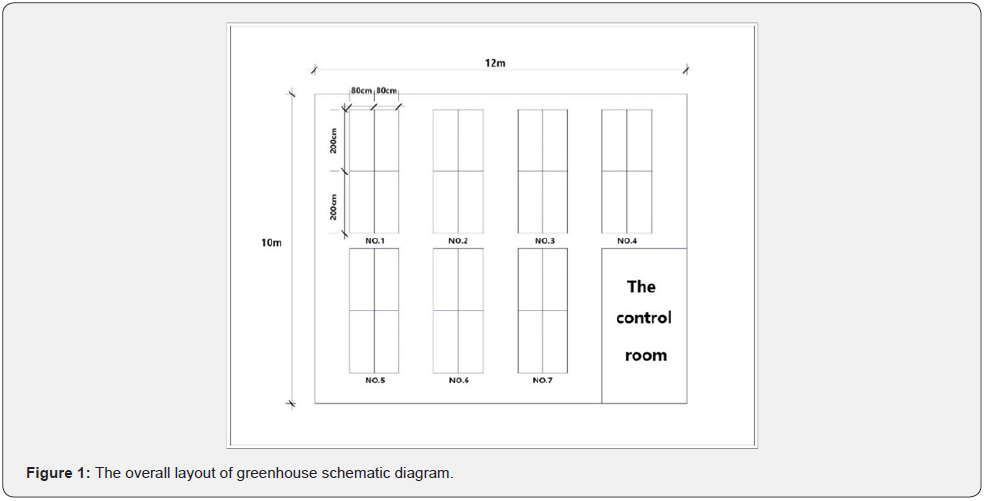
Automatic light filling system
Multi-layer stereo hydroponic system chooses red and blue LED filling light trip with stable light intensity and reasonable price (Type: BY-ZWT8-P2-0112,Flux: 3960 lm) Replenish light for hydroponic plants. The distance between the system’s internal supplementary light belt and the plant has passed a series of tests (20cm,30cm,40cm,50cm,60cm). Finally, when the height of the lamp belt is 40cm, the light filling effect is the best. At the same time, the number of single-layer patch strips in the hydroponic system was also tested. After testing, the width of the single-layer hydroponic frame is 80cm, it is necessary to lay 3 supplementary light strips. The start and closing of the fill light strip all adopt the centralized intelligent control of the control room (Figure 3), in the early stage of planting, according to the different plants cultivated, set the opening and closing time of each hydroponic frame fill light strip in advance, if the single layer of each hydroponic frame needs different light filling operations, it can be adjusted by the single layer controller of the light strip next to the hydroponic shelf of the light belt, minimizing human interference, and accurately and efficiently filling the light operation of the plant.

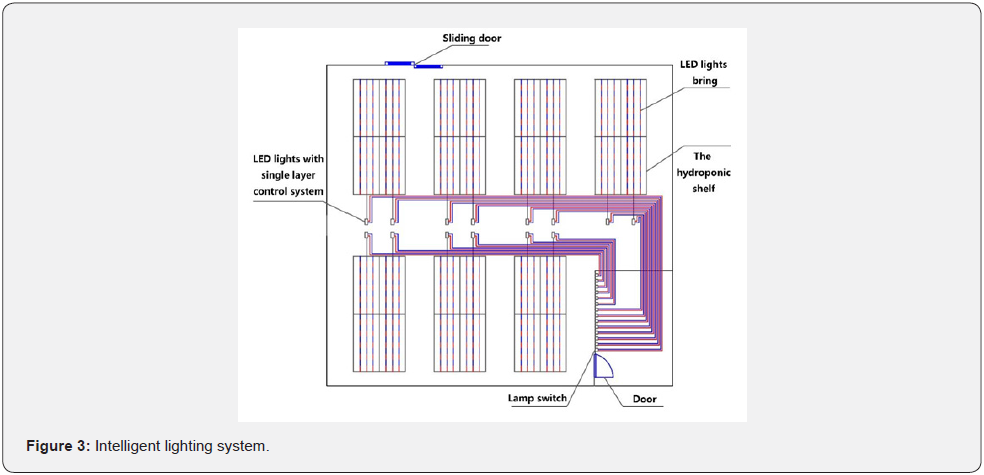
Temperature control system, intelligent ventilation system
Greenhouse integration by the control room unified scheduling of the intelligent temperature control system (Figure 4), the control principle of the temperature control system is as follows: First of all, the water is heated, hot water is sent to the hot air blower through the pipeline (each shed is equipped with four high-power industrial hot air blowers) and then the hot air blower is used to uniformly disperse the heating to the hydroponic room, and the start and close of each hot air blower is automatically adjusted by the temperature measured by the temperature sensor to ensure that the temperature in the hydroponic room is within a certain range. In addition, a ventilation device is installed in the hydroponic room to adjust the air freshness in the hydroponic room.
Water supply, drainage and automatic micro spray system
The indoor water supply is completed by external water storage tanks and supporting pressure vessels, and the water supply, drainage and automatic micro-spraying system in the greenhouse (Figure 5). Specifically: tap water is added to the water storage tank by the water level controller, and then the water is injected into the pressure tank by the action of the booster pump, and it reaches each hydroponic shelf through the transportation of the pipeline. The spray device is installed on the hydroponic shelf, 6-10 spray nozzles are installed on each floor, and the opening and closing of the spray device is adjusted at one time by the controller in the central control room to achieve full automation. After the water quality monitoring of the wastewater generated in the greenhouse, it was found that the wastewater contained more nitrogen, phosphorus, potassium, zinc, magnesium and other nutrients, and there were rich organic matter suspensions, so the wastewater could be used to irrigate farmland, save fertilizer, reduce costs, and continuously improve soil fertility. Therefore, the wastewater is collected uniformly and then irrigated to the farmland crops (Figure 6).
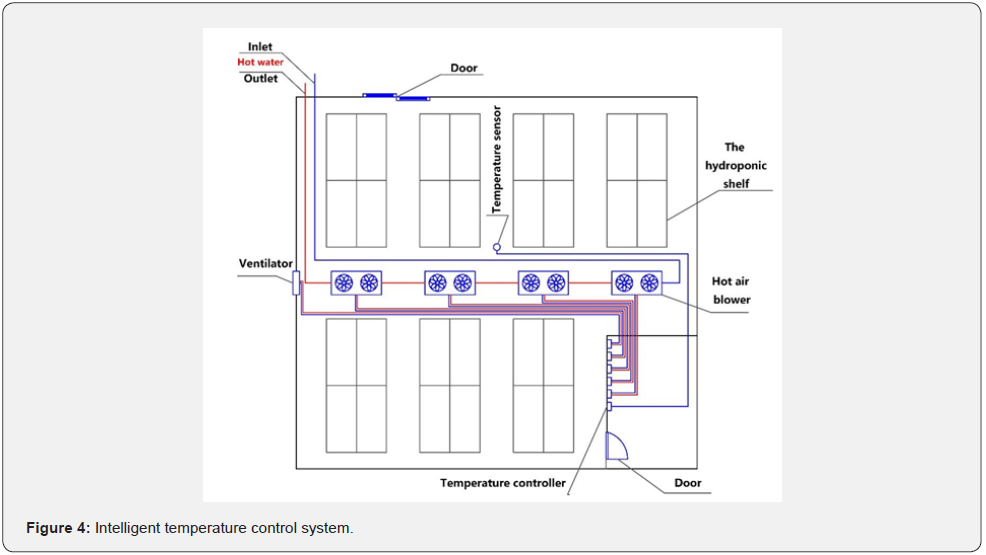
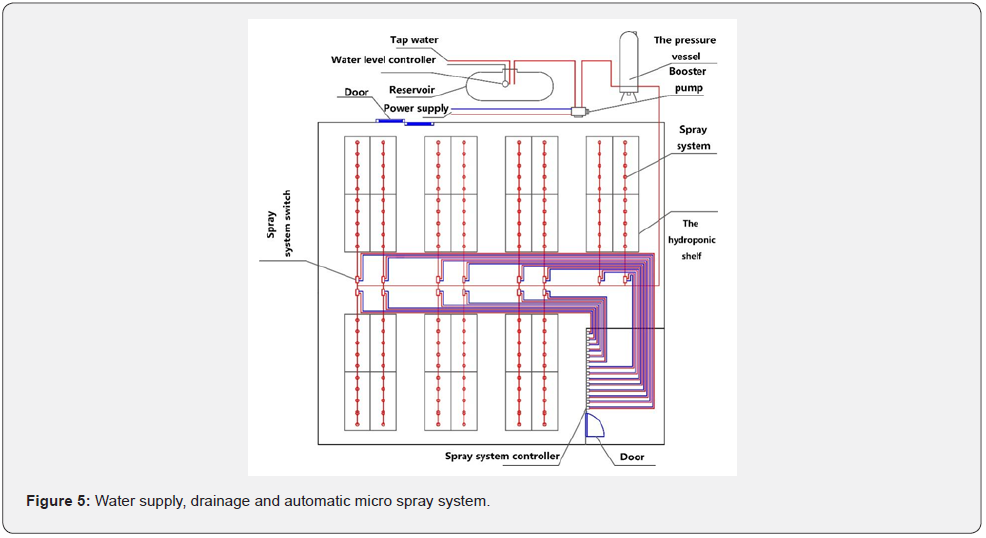
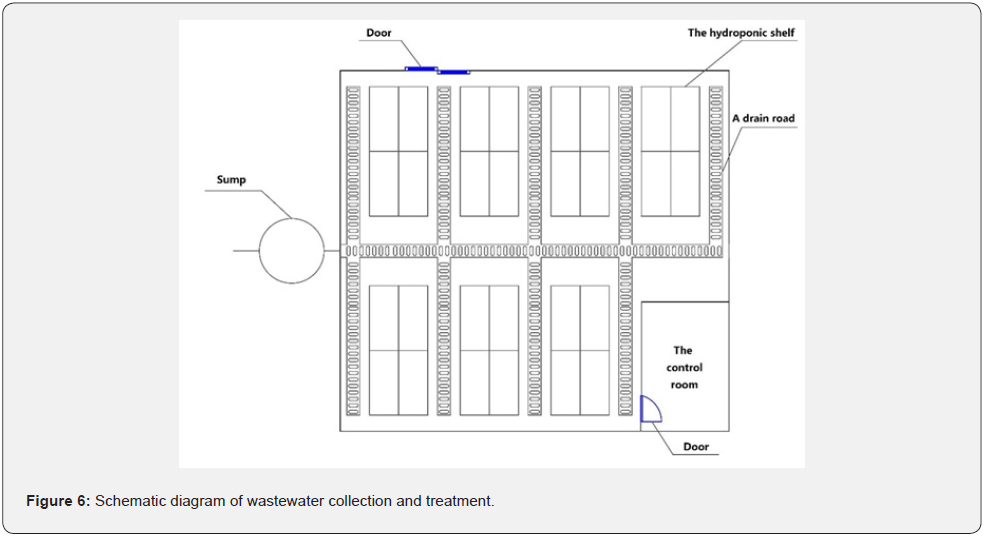
Hydroponic wheat pasture cultivation method
The seeds used in hydroponic forage are selected from the high-quality plump wheat seeds produced in the current year. Before hydroponics, the selected seeds are immersed in 2 times the volume of clean water to remove the debris floating on the surface of the water, and the disinfectant is added to the disinfectant for soaking (soak for 6 hours in summer, soak for 12 hours in winter, soak until the seeds are full of water). After soaking the seeds, spread evenly on the hydroponic rack, the thickness is 1cm, and the 1m2 is about 4kg. The water used for spraying is reduced to a weak alkaline nature by adding baking soda. The process of water, light filling and disinfection within one week after sowing of wheat is as follows (Figure 7 & 8):
i. Day 1:Do not spray water for bud protection from light.
ii. Day 2:Seeds began to germinate, continue to protect from light to bud, spray water every 4 hours for 35 seconds.
iii. Day 3:Shoot about 1cm long, continue to hide from light treatment, water every 3 hours for 35 seconds.
iv. Day 4:When the shoots grow to about 2cm, they turn yellow and green, and start to fill the light for 12 hours. Then spray disinfectant for disinfection, and spray water for 35 seconds every 2 hours.
v. Day 5:The shoots grew to about 6cm and were emerald green. The light was filled for 16 hours and the water was sprayed for 45 seconds every 2 hours.
vi. Day 6:The shoots grew to about 12cm, and the light was added for 18 hours, and the nutrient solution was sprayed once every 3 hours for 45 seconds.
vii. Day 7:Light filling 18 hours, water spraying 45 seconds every 3 hours, sprout length to 18-20cm, can be harvested.
78
Results and Discussion
Hydroponic herbage yields hydroponic and nutritional value
The hydroponic growth cycle of wheatgrass is a seven-day cycle and a year-round cycle of 54 cycles. In order to ensure that it can be sown every day and harvested every day, 7 groups of hydroponic racks are set up in the 120m2 greenhouse, and each group of hydroponic racks is composed of 4 hydroponic racks with a length of 2m, a width of 0.8m, and a height of 1.8m divided into five layers. The planting area of each group of hydroponic racks is 32m2, 4 kg per square meter of sowing, 7kg of fresh grass per kg of seed, 1000kg of fresh grass per day, and 360,000kg of pasture grass per year, which can be eaten by 400 sheep at the same time [17,18].
The preliminary study showed through the systematic determination of the nutritional status of wheat seedlings at each stage from germination to growth that wheat seedlings were incubated for about 6 days, and the seedlings contained a large number of vitamins, minerals, proteins and other nutrients necessary for humans and animals. After germination, the wheat continues to grow, when the leaves grow to about 10cm when the wheat seedlings are verdant and dazzling, with a special wheat fragrance, the milky white whisker roots at the bottom of the wheat seedling block not only make the young seedling grass form a lump and facilitate logistics operations, but also have high nutrition itself. After the malt continues to grow into wheat seedlings, the original main energy ingredient starch is converted into nutrients necessary for humans and animals, including rich vitamins (B1, B2, B6, B12) and easily digestible fiber, carotene, chlorophyll, amino acids and a large number of biological enzymes, pantothenic acid and folic acid, protein, and the mineral elements potassium, calcium, iron, phosphorus, magnesium, etc. [5,11]. Among them, cellulose, which is very easily digested by fibrinase and is not coated with lignin, is one of the most important characteristics of wheat seedlings. After absolute drying, the dry matter reaches 16% [7].
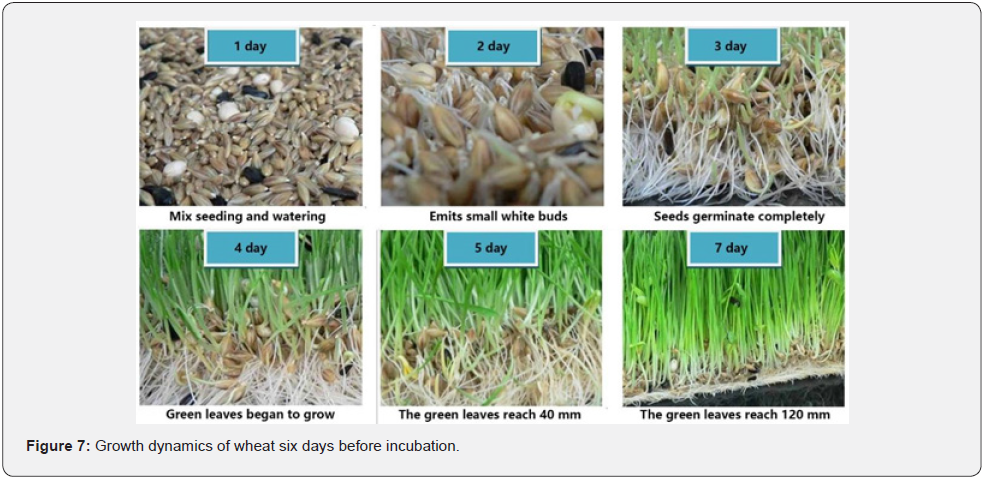
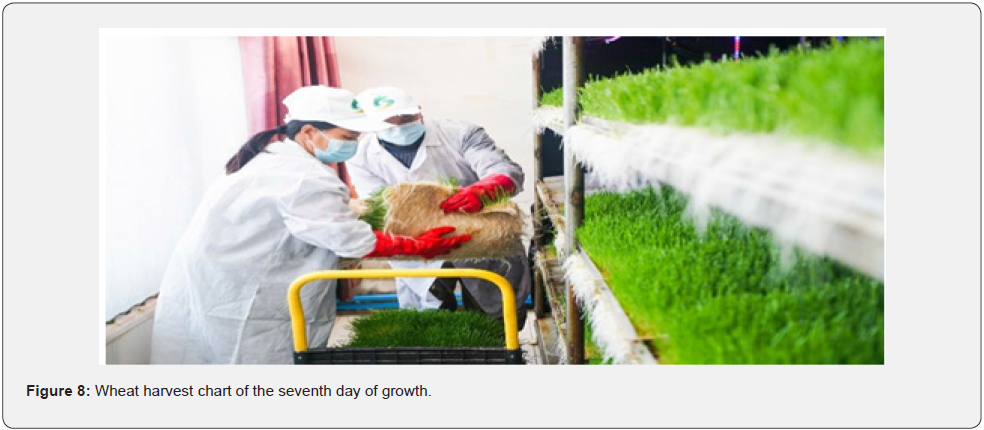
Cost accounting of hydroponic forage
The cost of production
Based on the production of 1000 kg pasture per day, the estimated daily operating costs are as follows (Currency: RMB): Wheat seeds: the average cost is 3 RMB per kilogram, 140 kilograms per day is required, and the cost is 420 RMB; Water: The production of each kilogram of pasture requires 2-3 liters of water, a total of 3× 1000 = 3000 liters, the cost is about 15 RMB; Power consumption: 13 RMB/ day for fill lights; The power consumption of the pump is about 30 kW / h, and the cost is 15 RMB / day; The electricity consumption for heat preservation and cooling is 120 kW / hour, and the cost is 60 RMB / day; Subtotal: 88 RMB / day; Employment: average salary of 200 RMB per day; The above total: 723 RMB, based on the above data, the production cost per kilogram of forage is about 0.73 RMB.
Cost comparison of hydroponic pasture with traditional feeding
Traditional feeding of 1 goat, the average daily need for corn straw 1kg grass, 0.2kg concentrate, need to grow 18 months out of the pen, need hay 18 months × 30 days× 1kg = 540kg, corn stalks 1000kg / 850 RMB, 540×0.85 = 459 RMB; Concentrate × 30 days in August× 0.2kg = 108kg, concentrate 1kg / 3 RMB, 108×3 = 324 RMB, 1 goat with corn straw as the forage needs to spend 459 RMB + 324 RMB = 783 RMB [19,20].
Feeding 1 goat with hydroponic wheatgrass requires an average of 2kg of fresh wheat grass per day, 0.1kg of concentrate, needs to grow for 12 months, needs grass to × 30 days in December×2kg =720kg, the cost of hydroponic wheatgrass is 1kg/0.73 RMB, 720×0.73=525.6 RMB; Concentrate × 30 days in December× 0.1kg = 36kg, concentrate 1kg / 3 RMB, 36×3 = 108 RMB, a sheep based on hydroponic wheatgrass feeding methods cost 525.6 RMB + 108 RMB = 633.6 RMB.
Raising a goat based on hydroponic wheatgrass saves 783- 633.6 RMB compared with the feeding method based on corn straw; The feeding cycle can be shortened by 6 months, saving 72 RMB of artificial labor; The total of the two items is 221.4 RMB.
Conclusions
The system is located in a completely controllable independent environment, not affected by external climatic conditions, can ensure that the annual output of forage is stable and balanced, and the production speed is fast, the production cost is low, and the problem of fresh grass used by farmers can be solved for a long time to meet the needs of large-scale breeding. In addition, after the seed raw materials are transformed through cultivation, many proteins and starches that are usually difficult to absorb or have low absorption efficiency can be converted into easily absorbed amino acids and glucose, and in the process of hydrolysis synthesis and photosynthesis, a large amount of vitamin nutrients can be synthesized, which greatly improves the bioconversion rate of feed (digestibility reaches more than 70%, hay is only 30%) [11], which helps to avoid diseases such as gastrointestinal colic; The harvested forage can be eaten with roots, clean and hygienic, good taste, and reduce the risk of respiratory diseases in animals; The forage produced is very rich in nutrients which is the most effective way to prevent animals from falling off the scale in the northern region in winter, protecting the interests of farmers.
Acknowledgment:
We are grateful to Xidong Tuo for the field technical support.
References
- Yu T, Dong Z, Wang X, Gao B, Fei T (2020) Metagenomics reveal correlations between microbial organisms in soils and the health of populus euphratica. Fron. Microbiol 11: 2095.
- Fei T, Gao B, Dong Z (2021) Technological breakthrough for the afforestation of populus euphratica in the Mu us desert in china. Sustainability 13: 13900.
- Dong AN, Deng W (2016) Establishment of the ecological security pattern in ecological fragile region based on sensitivity analysis-a case of yulin city in shaanxi province. J Anhui Agri Sci.
- Zhao Z, Wang P, Chen J, Zhang F (2021) Economic spillover effect of grass-based livestock husbandry on agricultural production-a case study in hulun buir, China. Technol Forecast Soc Change 168(1): 120752.
- Deng X, Wang Z, Zhao C (2016) Economic evolution in China ecologically fragile regions. Environ Dev Sustain 30(3): 552-576.
- Zhao Z, Wang G, Chen J, Wang J, Yue Z (2019) Assessment of climate change adaptation measures on the income of herders in a pastoral region. J Clean Prod 208: 728-735.
- Li Z, Sun X, Huang Z, Zhang X, Zhai B (2020) Changes in nutrient balance, environmental effects, and green development after returning farmland to forests: a case study in ningxia, china. Sci Total Environ 735(5): 139370.
- Dharmateja P, Kumar M, Pandey R, Mandal PK, Babu P, et al. (2021) Deciphering the change in root system architectural traits under limiting and non-limiting phosphorus in indian bread wheat germplasm. Plos one 16(10): e0255840.
- Ali H, Zulkali M (2011) Utilization of agro-residual ligno-cellulosic substances by using solid state fermentation: a review. J Food Technol Biotech Nutrition 6(1): 5-12.
- Hassan G, Sharifi M, Nahid T, Afrasiabi S (2022) A new method for green forage production: Energy use efficiency and environmental sustainability. J Clean Prod 363: 132562.
- Kfmaa B, Mams A, Maa A (2019) Evaluation of hydroponic barley sprouts as a feed supplement for laying japanese quail: effects on egg production, egg quality, fertility, blood constituents, and internal organs. Anim Feed Sci Technol 252: 126-135.
- Foad K (2017) Evaluation of baker's yeast (saccharomyces cerevisiae) supplementation on the feeding value of hydroponic barley sprouts for growing rabbits. EPSA 37(3): 833-854.
- Gebremedhin W (2015) Nutritional benefit and economic value of feeding hydroponically grown maize and barley fodder for Konkan Kanyal goats. J Agric Vet Sci 8(7): 24-30.
- Ayssiwede S, Dieng A, Bello H, Chrysostome C, Hane M, et al. (2011) Effects of moringa oleifera (lam.) leaves meal incorporation in diets on growth performances, carcass characteristics and economics results of growing indigenous senegal chickens. Pak J Nutr 10(12): 1132-1145.
- Farghaly M, Abdullah M, Youssef I, Abdel RI, Abouelezz K (2019) Effect of feeding hydroponic barley sprouts to sheep on feed intake, nutrient digestibility, nitrogen retention, rumen fermentation and ruminal enzymes activity - sciencedirect. Livest Sci 228: 31-37.
- Halgamuge M, Bojovschi A, Fisher P, Le T, Murphy S (2021) Internet of things and autonomous control for vertical cultivation walls towards smart food growing: a review. Urban For Urban Gree 61: 127094.
- Ahamed M, Sultan M, Shamshiri R, Rahman M, Aleem M, et al. (2023) Present status and challenges of fodder production in controlled environments: A review. Smart Agri Technol 3: 100080.
- Wang H, Hu Y, Yan H, Liang Y, Guo X, et al. (2022) Trade-off among grain production, animal husbandry production, and habitat quality based on future scenario simulations in xilinhot. Sci Total Environ 2022 817: 153015.
- Girma F, Gebremariam B (2018) Review on hydroponic feed value to livestock production. J Sci Innov Res 7(4): 106-109.
- Naik P, Swain B, Singh N (2015) Production and utilisation of hydroponics fodder. Indian J Anim Nutr 32(1): 1-9.






























